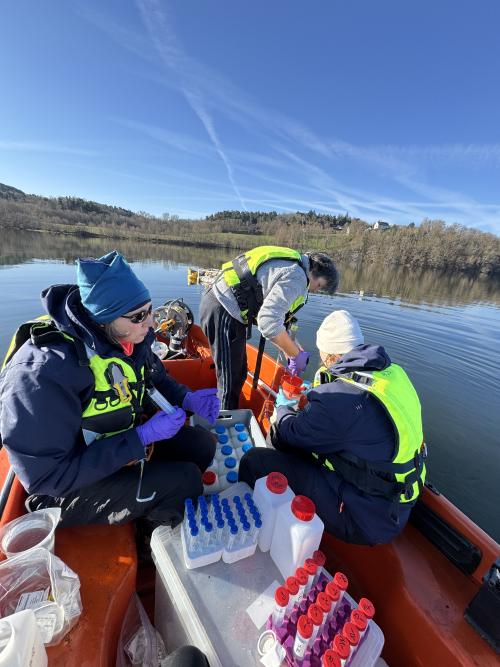Current Projects
ANR DIAMOND 2024-2028: Diversity and metabolIc Adaptation of Microorganisms in increasing OxygeN Depleted freshwaters
Project coordination : Cécile Lepère, Corinne Petit, Gisèle Bronner
One major effect of the global warming is the increasing of oxygen (O2) depleted zone in aquatic ecosystems. Indeed, a recent study showed that over the past forty years, O2 levels in the deep waters of temperate lakes have dropped by nearly 19%. O2 being the support system for aquatic food webs, its decline has strong implications on the whole ecosystem, threatening biodiversity and ecosystem services. While the effect of the decline of O2 content is currently studied for marine animals, microorganisms (microbial eukaryotes and prokaryotes) are rarely considered in this context. Microorganisms are nevertheless major components of aquatic environments, maintaining the overall ecosystem. The ecological impacts of the expansion of O2-depleted waters are suspected to affect both directly and indirectly the microbial communities thriving in these habitats (e.g taxa loss, niche adaptation, interactions perturbation, migration, species replacement, etc). Moreover, the decrease in O2 levels in waters, could be accompanied by an increase in greenhouse gases production (e.g. nitrous oxide-N2O, carbon dioxide-CO2, methane-CH4) carried out by archaea and bacteria.
This proposal aims to enhance our knowledge on the dynamics of microbial diversity and adaptation in response to global changes, as well as on the functioning and resilience of freshwater lakes. Past (paleolimnological approach), present (3 years monitoring, lake Aydat) and future (microcosm experiments) microbial diversity will be assessed in relation to O2 concentration using metabarcoding. Metabolic adaptation will be studied through metatranscriptomics. Microorganisms (taxa and genes) involved in greenhouse gases production will be identify and gas (CH4, CO2, N2O) concentrations will be measured in relation the lake dynamic as well as in experimental work. Finally, we will propose a revised trophic food web in relation to O2depletion.


ANR Metha-Nov 2025-2028: Advancements in sustainable Methane production through inNovative room temperature bio-methanation
Project coordination: Khaled Fadhlaoui
The production, transport, costs and emissions associated with the use of fossil fuels currently pose a major problem in socio-economic, environmental and health terms. In France, for example, natural gas (>97% CH4) accounts for almost 20% of final energy consumption, and its use generates almost 1/5th of greenhouse gas emissions. In this context, France has devoted considerable effort in recent decades to developing new strategies to guarantee renewable and autonomous energy production. Major progress has been made, notably with the emergence of decarbonized technologies (solar, wind), but also in relation to the valorization of biomass and the production of bio-CH4. This latter strategy not only contributes to France's energy independence, but also plays an essential role in recycling organic waste and reducing greenhouse gas emissions, including CO2. The Metha-Nov project is part of this strategy. Indeed, thanks to the use of microorganisms (methanogenic archaea and bacteria) from a temperate lake (Lake Pavin) and the development of a new two-stage reactor, significant advances in microbiological and process engineering are expected. The aim is to be able to offer a high-performance, energy-efficient in situ methanation method at ambient temperature.
GENetic MODeling of microbial community responses (GENMOD)
A Framework for Predicting Microbial Community Dynamics Using Genetic Signatures
2025-2029
Project coordination: Sara Beier [https://lmge.uca.fr/annuaire/sara-beier-1#/]
Global change due to human activities causes an increasing number of disturbed ecosystems and poses a challenge to humanity because human life depends on the stability of ecosystem services. Microorganisms are main drivers of element cycling and their dynamics are therefore fundamental for all biological processes and relevant for ecosystem services in natural as well as engineered systems. For untangling the different factors that contribute to the functional and compositional dynamics of microbial communities, it is pivotal to understand the mechanisms that regulate their response to disturbances.
Previous research suggests that alpha diversity patterns, species interactions, and individual species traits can influence how microbial communities respond to environmental fluctuations. Emerging evidence further indicates that the prevailing mechanisms shaping microbial community dynamics in aquatic ecosystems may vary depending on the level of eutrophication. For example, prokaryote–phage interactions may differentially affect prokaryote species diversity and their traits across ecosystems with varying eutrophication levels, potentially due to shifts between lytic and lysogenic infection cycles.
This project aims to identify and evaluate genetic signatures that reflect diversity structures, species interactions, and species traits, in order to determine the conditions under which specific mechanisms drive the responses of aquatic microbial communities to environmental disturbances.
The overall project aim is to develop and refine predictive models of microbial compositional and functional dynamics in fluctuating environments, using genetic signatures as key predictor variables.
PaléoMicro 2024-2026 (emergence UCA and EC2CO funding): Paleo-microbiology : diversity and long term dynamic of aquatic Microsporidia
Project coordination : Cécile Lepère
Parasites have long been underestimated, but their central role in ecosystem functioning is now recognized. They can represent a significant portion of ecosystem diversity, ranging from 30% to 71%. The development of high-throughput sequencing has enabled a better understanding of the diversity of aquatic microbial eukaryote communities, including a wide diversity of parasites. However, certain groups of parasites, such as microsporidia (parasites of invertebrates and vertebrates, including humans), remain little studied due to their genetic divergence from other eukaryotes. Recent studies conducted in the lab have revealed a previously unknown diversity of microsporidia in aquatic ecosystems. These parasites could have a significant impact on aquatic food webs because of their wide range of hosts. Human microsporidia have also been found in lake water columns. However, there is little information on the long-term temporal dynamics of microsporidia and their diversity in relation to the history of the lake, its uses, and environmental variables. Thus, the aim of this project is to study the temporal dynamics of microsporidia in connection with the Anthropocene (since 1900) in a lake under anthropogenic influence, using a paleogenomic approach.

